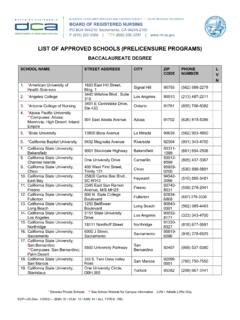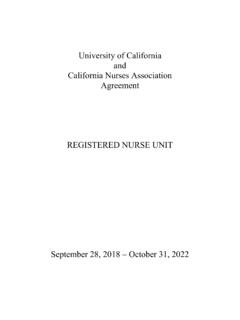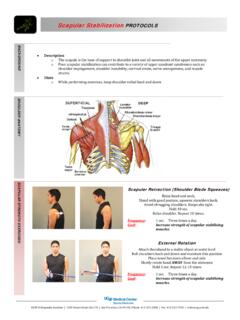Transcription of Radical Prostatectomy – A Patient Guide
1 1 Radical Prostatectomy A Patient GuideDepartment of Urology UCSF Helen Diller Family Comprehensive Cancer Center university of california , San FranciscoOverview A Radical Prostatectomy is a surgical procedure whereby the prostate gland is removed. Lymph nodes near the prostate can be removed at the same time. Radical Prostatectomy is one option for men with clinically localized prostate cancer. Potential advantages include the following: 1) removal of the prostate and analysis by a pathologist allows accurate assessment of cancer aggressiveness (stage and grade); 2) follow-up after surgery is straightforward: the serum PSA (prostate specific antigen) level should be undetectable, and recurrence of cancer is relatively easy to detect because of this; 3) radiation can be given after surgery, if necessary, with a relatively low risk of any additional side effects; and 4) surgery appears to be associated with a very limited risk of late ( beyond 5 years) local recurrence if careful and sensitive PSA testing is performed.
2 Patients who are in good health, have a long life expectancy and have cancers which appear to be confined to the prostate gland are candidates for Radical Prostatectomy . Some men with more advanced cancers may benefit from the procedure as well. The procedure is associated with certain side effects, although major complications are very rare. Many men may be candidates for a nerve-sparing Radical Prostatectomy whereby sexual function may be is the prostate gland and where is it located? The prostate is a male gland which is normally the size of a walnut (about 20-25 grams). It is located behind the pubic bone and below the bladder and surrounds the upper portion of the urethra (canal that drains urine from the bladder).
3 The prostate gland lies in front of the rectum, and part of its surface can be felt during a rectal examination. Adjacent to the prostate are the seminal vesicles, two small glands which are also removed during Radical Prostatectomy . The function of the prostate and seminal vesicles is to secrete most of the fluid which, together with sperm, constitutes is a Radical Prostatectomy ?A Radical Prostatectomy is surgery to remove the entire prostate gland and seminal vesicles and, on occasion, regional lymph nodes after a diagnosis of prostate cancer is made. Radical Prostatectomy is one of many options for the treatment of prostate cancer. You should discuss all options with your Prostatectomy can be done via an incision made in the abdomen ( Radical retropubic Prostatectomy ) or in the perineum, the area between the scrotum and the anus ( Radical perineal Prostatectomy ).
4 Alternatively, it may be done with laparoscopy ( laparoscopic Radical Prostatectomy ). Laparoscopy is a technique in which surgery is performed by making small incisions and passing specially designed telescopes and instruments into the body. Laparoscopic Radical Prostatectomy is a relatively new technique, which may result in less discomfort and earlier return to work. At UCSF we perform laparoscopic Radical prostatectomies using a robotic surgical system called the da Vinci robot. The system features magnification and surgical precision. Outcomes in terms of cancer control, urinary function and sexual function are generally similar to a Radical retropubic Prostatectomy . The robotic approach has been modified based on our large experience with open surgery in order to optimize outcomes.
5 The subtle differences between the procedures can be discussed with your surgeon. At UCSF, the majority of procedures are done using a robotic approach for the following reasons: the robotic approach appears to able to remove the prostate cancer equally as well as the open approach, it is associated with somewhat less blood loss and an earlier return to normal activities and may be associated with an enhanced ability to spare the neurovascular bundles. However, selected patients, usually those with more advanced cancers, may benefit from the open addition to removing the prostate gland, the lymph nodes in the area of the prostate may be removed either before or during the same operation. This is done to determine if the prostate cancer has spread to the lymph nodes.
6 This procedure is called "pelvic lymph node dissection." The risk of having cancer in the lymph node can be estimated and only men with a moderate or high risk of pelvic lymph node metastases need to undergo pelvic lymph node dissection. Criteria for lymph node dissection vary, but may include high grade (Gleason pattern 4 or 5), higher PSA values and/or possible extra-prostatic disease based on preoperative would I choose to have a Radical Prostatectomy ? Radical Prostatectomy is one of several options for men whose prostate cancer still appears to be localized to the prostate. It allows, in most cases, for complete removal of the cancer. Once the prostate is removed, one can tell how advanced the cancer is, what the risk for cancer recurrence is and whether or not additional treatment may be needed.
7 It is relatively easy to follow men who have undergone Radical Prostatectomy to be sure their cancer is gone. Once the prostate is removed, PSA should fall to undetectable levels within six weeks. Radiation can be given after surgery, if necessary, with a relatively limited risk of any additional side who choose Radical Prostatectomy should be in very good health, have a life expectancy exceeding 10 years, have cancers that appear to be localized to the prostate gland and have discussed all available treatment options with their doctors. Some men with prostate cancer extending beyond the prostate gland may be candidates for the procedure as well. Radical Prostatectomy may occasionally be an option when prostate cancer recurs after radiation or other treatments.
8 This approach ("salvage Prostatectomy ") carries higher risks of side effects, and should be considered will happen before surgery?Before surgery, a number of tests will be performed to determine the extent of the disease. These tests include blood tests, transrectal ultrasound, and a prostate biopsy. In selected patients, a bone scan and a CT or MRI scan of the abdomen and pelvis may be done. You will have a physical examination performed and discuss the various types of anesthesia with anesthesiologists. This visit will be arranged by your doctor and will occur the week before surgery. You will be admitted to the hospital on the day of your surgery. However, you may begin a bowel prep at home on the day before your surgery.
9 This is done to cleanse the bowel and may consist of a clear liquid diet, medication to promote bowel movements, and/or an enema. This is a routine preparation done before many types of abdominal and pelvic surgery. What type of anesthesia should I have and do I need to donate blood?There are various types of anesthesia. General anesthesia is a technique whereby the anesthesiologists give medication, which allows patients to be asleep or unconscious during the procedure. Spinal or epidural anesthesia are techniques whereby medication is instilled into the space around the spinal cord. Epidural anesthesia allows for the delivery of medication postoperatively through a small tube or catheter in the back, resulting in continuous levels of pain medication.
10 The techniques may be combined. Most UCSF Radical Prostatectomy patients do not require spinal or epidural anesthesia; we normally use general anesthesia with ketorolac, an anti-inflammatory medication, after surgery. With the laparoscopic approach, general anesthesia is of autologous blood (your own blood) is offered to patients, but given the limited blood loss noted by most experienced surgeons, it may not be necessary. This limited blood loss tends to be even less with laparoscopic (robotic-assisted) surgery. If you do wish to donate blood, 1 to 2 units of blood can be stored and used at the time of surgery if it is necessary. What happens during surgery? Lymph node dissectionWhen prostate cancer spreads (metastasizes) it often does so into lymph nodes in the area of the prostate.













